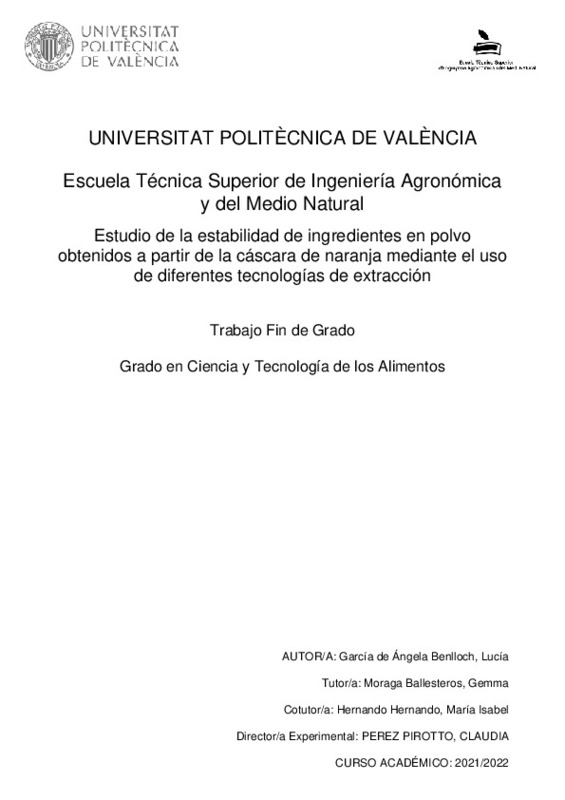|
Resumen:
|
[EN] The industrialization of the orange produces high amounts of organic waste, which represents an environmental problem. Proper management is important to enable the reduction of waste and related problems, so good use ...[+]
[EN] The industrialization of the orange produces high amounts of organic waste, which represents an environmental problem. Proper management is important to enable the reduction of waste and related problems, so good use of by-products can represent a key strategy for a circular economy. Through the reuse of by-products, it is possible to develop functional ingredients for the food industry, adding value to the citrus production chain. The objective of this work was the characterization and study of the stability of the powdered ingredients obtained from orange peel through the use of different extraction technologies and subsequent drying, after storage at different relative humidities (20 ºC). Sorption isotherms were obtained, fitting four models, BET, GAB, Henderson and Caurie. In turn, the glass transition temperature (Tg) was studied by differential scanning calorimetry (DSC) and the variations in colour and mechanical properties were observed. Finally, the antioxidant capacity and the content of total phenols were analyzed. Both the physical properties and the antioxidant capacity and the content of phenolic compounds were directly influenced by the storage conditions of the powder samples. In turn, the extraction technologies used played a decisive role, since they directly influenced the hygroscopicity and composition of the powder's ingredients. In the extruded sample the deterioration reactions were reduced, it maintained its colour and texture characteristics in better conditions, in addition to the loss of bioactive compounds being reduced.
[-]
[ES] La industrialización de la naranja produce elevadas cantidades de residuos orgánicos, lo que representa un problema ambiental. Es importante una gestión adecuada de los residuos para posibilitar la reducción de estos ...[+]
[ES] La industrialización de la naranja produce elevadas cantidades de residuos orgánicos, lo que representa un problema ambiental. Es importante una gestión adecuada de los residuos para posibilitar la reducción de estos y los problemas relacionados, por lo que un buen uso de los subproductos puede representar una estrategia clave en el marco de una economía circular. Mediante la reutilización de los subproductos, se hace posible el desarrollo de ingredientes funcionales para la industria alimentaria, añadiendo valor a la cadena productiva de los cítricos.
El objetivo de este trabajo fue la caracterización y el estudio de la estabilidad de ingredientes en polvo obtenidos a partir de la cáscara de naranja mediante el uso de diferentes tecnologías de extracción y posterior secado, tras su almacenamiento a diferentes humedades relativas (20 ºC). Se obtuvieron las isotermas de sorción, ajustándose a cuatro modelos, BET, GAB, Henderson y Caurie. A su vez se estudió la temperatura de transición vítrea (Tg) por calorimetría diferencial de barrido (DSC) y se observaron las variaciones en el color y las propiedades mecánicas. Finalmente, se analizó la capacidad antioxidante y el contenido en fenoles totales.
Tanto las propiedades físicas como la capacidad antioxidante y el contenido en compuestos fenólicos se vieron directamente influenciados por las condiciones de almacenamiento de los ingredientes en polvo. A su vez jugaron un papel decisivo las tecnologías de extracción usadas, ya que influyeron directamente en la higroscopicidad y composición de los ingredientes en polvo. En la muestra obtenida por extrusión las reacciones de deterioro se vieron reducidas, mantuvo en mejores condiciones sus características de color y textura, además de verse menguada la pérdida de compuestos bioactivos.
[-]
|







